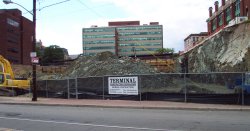
Since March 11, four months of excavation for a Stevens’ parking garage has been completed but the Planning Board has issued no approvals for this project.
(July 2002)
The Hoboken Zoning Ordinance requires that the Planning Board grant site plan approval for parking facilities of 50 cars or more. Flaunting this requirement, Stevens Institute of Technology submitted to the Hoboken Building Department plans dated September 21, 2001 for a four-story parking garage that the Board never approved or even considered. Two months later on November 20, Building Inspector Alfred Arezzo granted a permit to Stevens to construct a “foundation and parking garage as per planning and zoning approval” at this site on Sixth Street and River Terrace.
For the past four months, beginning on March 11, 2002, Stevens has drilled, blasted and carted away over 40,000 cubic yards of asbestos-containing serpentine rock, opening up a cavernous hole, to make way for this massive waterfront garage. But since last May the Hoboken Planning Board has questioned why their authority has been undermined by granting this permit. At their July 2nd meeting, the Board authorized their attorney, Douglas Bern to write to the Mayor and Council requesting their intervention.
Since the construction permit lacks Planning Board authority, the City of Hoboken could act to revoke this document. Stevens Institute has argued that they are simply building a foundation for the Babbio Center also known as the School of Technology Management. The Babbio Center, a six story building approved by the Planning Board in February of 2001, however, contains only one level of surface parking for 105 cars and the structure itself is confined to a site on the corner of River Terrace and Sixth Street. The current excavation is some forty to fifty feet below grade at this location and extends all the way to the eastern portion of this block at Sinatra Drive.
On April 17, 2002, Ron Hine of the Fund for a Better Waterfront (FBW) wrote to Planning Board Chairman Thomas Mooney requesting that the permit be revoked, claiming that it was issued without the necessary Board approvals. Initially, Mooney responded by letter stating that the Board had no authority to take such action. But at subsequent meetings of the Planning Board, this issue was taken up and the Board authorized its attorney Douglas Bern to write a letter to Building Inspector Alfred Arezzo and Zoning Officer Joel Mestre. This May 15th letter from Bern requested “a written explanation to the Board assuring it that the work is strictly in accordance with the Resolution granting Preliminary Site Plan Approval” for the School of Technology Management. Mr. Arezzo wrote back to Bern on June 3 asserting that he received a certificate of zoning compliance from Zoning Officer Joel Mestre for this project. Mestre failed to respond in writing to Bern’s letter.
According to Hine, an exposed parking garage facing the waterfront represents poor planning and poor urban design. “Stevens should put a good face on the waterfront — well designed buildings. This would provide something attractive for us to look at. It also would provide extraordinary views from the classrooms, offices and laboratories facing the riverfront and New York City skyline. It makes no sense that those same views be provided to parked cars.” FBW’s planner, Craig Whitaker, has already drawn detailed plans showing how this can be done, shielding the parking behind new buildings that front on Sinatra Drive between Fifth and Sixth Streets.
On March 1, 2002, the Hoboken Building Department granted Stevens Vice President Roger Cole a blasting permit for this site. On the permit application, the check off for asbestos abatement was left blank. A month after the blasting of the serpentine rock began on March 11, FBW discovered that this rock contained asbestos and filed a complaint with the Hoboken Health Department. Since that time an acrimonious debate has ensued about the extent of the health hazard that has been posed by this operation. Stevens, in a letter to FBW’s funders has insinuated that FBW was a cult and threatened to sue the group for libel regarding their statements on the asbestos problem.

